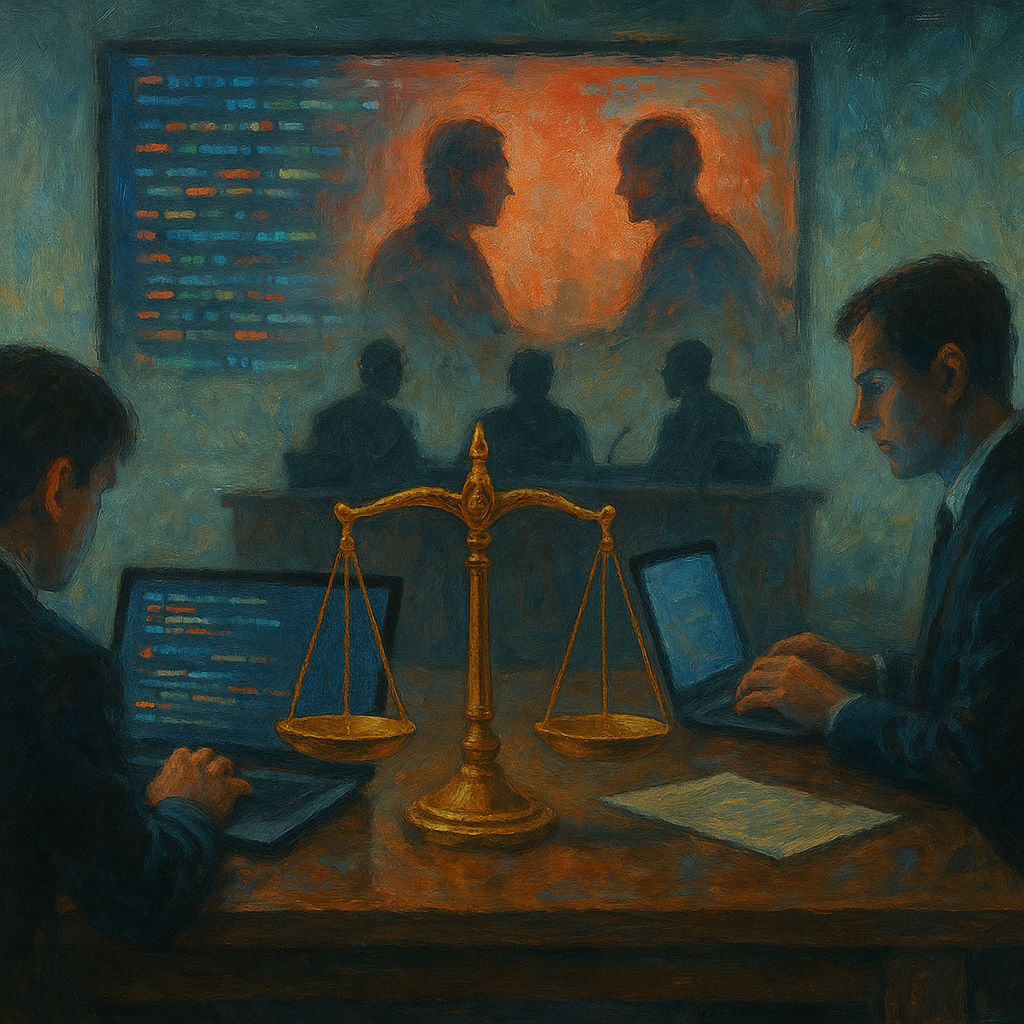Every revolution in trade has carried with it a quieter revolution in conflict. When merchants of the Middle Ages shipped spices and silk across continents, they did not turn to kings or parliaments to settle disputes. They turned instead to each other, creating informal courts and rules that became known as the lex mercatoria (the law of merchants). Arbitration was born not in marble courtrooms, but in the backrooms of ports and marketplaces, to keep commerce moving when trust faltered.
Fast forward to the 21st century, and arbitration has become the hidden engine of the global economy. It is quicker than litigation, more flexible than state courts, and in many ways more powerful, deciding everything from billion-dollar construction disputes to football transfer rows. Yet while its roots are centuries old, arbitration is now colliding head-on with the digital revolution.
In Web2, platforms like eBay and PayPal quietly built vast, private justice systems. eBay’s Resolution Centre alone has handled more than 60 million disputes a year, making it, in effect, the largest court in the world one run not by judges, but by algorithms and corporate policies. This was arbitration reimagined for the age of platforms: efficient, invisible, but also unaccountable.
And in Web3, the stakes climb higher still. When “code is law,” what happens when code fails? Smart contracts cannot empathise, and decentralised organisations cannot phone a judge. Yet billions of dollars in cryptocurrencies and assets depend on precisely these systems. The collapse of The DAO in 2016 showed what happens when disputes erupt with no clear authority to settle them: chaos, schism, and a blockchain community forced to play judge and jury.
Arbitration has always been the quiet architecture of trust in commerce. Today, it is being rewritten in real time in courtrooms, in corporate policies, and on blockchains. The question for our age is not whether disputes will arise in the digital economy, but whether we can design systems of resolution that are fair, accountable, and built to withstand the new world of code and capital.
From Market Stalls to Global Commerce: The Origins of Arbitration
Arbitration did not begin as a legal innovation drafted in parliaments or universities. It began out of necessity. In medieval Europe, long before the rise of nation-states with uniform legal systems, merchants needed a way to resolve disputes quickly, cheaply, and across borders. If a Flemish weaver sold cloth to a Genoese trader and the goods were late, taking the matter before a king’s court could take months and cost more than the shipment itself. Instead, traders relied on their peers. Merchant guilds, fairs, and trading posts became informal courts where disputes were heard by respected elders, and decisions were enforced by reputation. This body of practice (lex mercatoria or law of merchants) was not written in statute books but in contracts, custom, and trust.
As trade expanded with the Renaissance and the age of empire, arbitration followed. The Dutch East India Company and the British East India Company, two of the world’s first multinational corporations, relied on arbitration to keep global supply chains from breaking under the weight of disputes. By the 19th century, arbitration had evolved into a recognised institution, formalised through chambers of commerce and codified in international conventions. In 1923, the Geneva Protocol on Arbitration marked one of the first global agreements to recognise and enforce arbitration awards across borders, laying the groundwork for today’s New York Convention, which now binds over 160 countries.
By the late 20th century, arbitration had become the engine room of globalisation. Mega-projects in construction, shipping, oil, and finance could not function without it. The International Chamber of Commerce in Paris and the London Court of International Arbitration became arbitral powerhouses, deciding cases worth billions. And for businesses wary of politicised courts or drawn-out litigation, arbitration offered neutrality, discretion, and speed.
Yet even as it professionalised, arbitration retained something of its medieval character: it was still a form of justice that operated alongside and often outside the state. And this tension between official law and private ordering would come to define its role in the digital age.
Web2 and the Rise of Platform Justice
If arbitration was once the tool of merchants and multinationals, the dawn of Web2 transformed it into something far larger and far more invisible. For the first time, everyday consumers became participants in a digital economy where disputes were measured not in millions, but in millions of cases.
Take eBay. Founded in 1995 as an online auction site, it quickly grew into a global marketplace where strangers traded everything from baseball cards to cars. Trust between buyers and sellers was fragile, and traditional courts were simply too slow and expensive for a £50 dispute over a camera or a set of sneakers. Thus, eBay built its own solution: an online Resolution Centre. By the mid-2000s, it was handling more than 60 million disputes a year, making it the largest dispute resolution system in the world. PayPal, acquired by eBay in 2002, expanded this model, providing refunds and chargeback mechanisms that effectively arbitrated trust between users and merchants.
This was arbitration reimagined for the platform age: fast, digital, and ruthlessly efficient. A buyer clicks “dispute,” an algorithm weighs evidence, and a refund is issued, often without human intervention. For users, it felt seamless. For platforms, it was essential becoming the invisible glue that held the promise of trust in anonymous transactions.
But efficiency came at a price. Unlike traditional arbitration, Web2’s dispute resolution systems were entirely private. The rules were written by corporations, the “judges” were algorithms or customer service agents, and the decisions were final. There was little transparency, no meaningful appeal, and no guarantee of fairness beyond the platform’s commercial incentives. Sociologists call this “platform governance”: the quiet shift of judicial power away from states and into the hands of tech companies.
In effect, companies like eBay, PayPal, Amazon, and Airbnb became the world’s largest private courts. They resolved disputes at a scale national judiciaries could never dream of, but they did so without the safeguards of due process or public accountability. And this shift carried profound consequences. If the lex mercatoria was once the merchants’ law, then Web2 had created a new kind of lex digitalis: justice written not in statutes but in terms and conditions.
When Code Becomes Law: Arbitration in Web3
If Web2 platforms quietly became private courts, Web3 attempted something more radical: to replace courts altogether. With the rise of blockchain and smart contracts, arbitration was not just outsourced, it was automated. Agreements were written directly into code, executed automatically, and enforced without human intervention. “Code is law,” as legal scholar Lawrence Lessig famously put it.
But what happens when code goes wrong?
The question became unavoidable in 2016 with the collapse of The DAO, a decentralised investment fund built on the Ethereum blockchain. Investors had poured in over $150 million worth of ether, trusting the smart contracts to govern their pooled capital. Then a hacker exploited a flaw in the code, draining $50 million. It was not theft in the conventional sense. The hacker had followed the rules as written, but not as intended. Arbitration, in the human sense, was absent. There was no court to appeal to, no platform moderator to lodge a complaint with. The only recourse was for the Ethereum community itself to intervene, rewriting the blockchain’s history through a “hard fork” to reverse the damage. The decision split the community and gave rise to Ethereum Classic and a timely reminder that even in decentralised systems, arbitration cannot be eliminated. It merely takes new forms.
Since then, innovators have been building digital mechanisms for arbitration that go beyond “hard forks.” One of the most notable is Kleros, a decentralised arbitration protocol often described as a “blockchain jury.” Users stake tokens to be selected as jurors, then review evidence and vote on disputes ranging from escrow conflicts to token-listing disagreements. Incentives are designed to reward honest voting, creating a crowdsourced system of justice. Another example is Aragon Court, built to resolve governance disputes within decentralised organisations (DAOs). Projects like Mattereum go further, attempting to connect digital arbitration with enforceable real-world contracts, particularly in the trade of physical assets.
These experiments mark the next stage of arbitration: not private platforms, but public protocols. Their promise is that justice can be transparent, borderless, and tamper-proof, an antidote to the opaque systems of Web2. Yet they also raise unsettling questions. Can token-weighted juries truly deliver fairness, or will they simply amplify inequalities of wealth and influence? Can “crowdsourced justice” prevent bias, or does it risk mob rule disguised as democracy?
What Web3 demonstrates most clearly is that arbitration cannot be wished away. Even in a world where code enforces contracts, disputes emerge over bugs, intent, or unforeseen circumstances. And when they do, communities must still decide how to balance fairness, efficiency, and accountability.
The Ethics of Digital Arbitration
Arbitration, whether in guild halls, platform dashboards, or blockchain protocols, has always carried an ethical question at its core: who decides what is fair? In the analogue age, the answer was arbitrators often representing experts chosen by both sides, trusted to balance interests impartially. In the Web2 age, the answer shifted uncomfortably to corporations, whose algorithms resolved disputes according to internal rules, often aligned more with profit than justice. In Web3, the answer is supposed to be the community itself (jurors, token-holders, or smart contracts). Yet the ethics of this model are anything but settled.
The sociologist Max Weber described bureaucracy as both efficient and alienating, a system that reduces human life to rules and procedures. Web2’s algorithmic arbitration embodied this critique, stripping disputes of context in the name of scale. Web3 promised something different: collective governance, transparency, and decentralised authority. But as political theorists remind us, democracy itself can be imperfect. Hannah Arendt once warned of the dangers of “rule by nobody,” a system where decisions are made without clear accountability. A blockchain jury of anonymous token-holders risks precisely this: justice without responsibility.
There is also the problem of inequality. In theory, decentralisation distributes power; in practice, token-based systems often concentrate it. Wealthier participants can buy influence, shaping outcomes much as corporate donors do in politics. Instead of dismantling hierarchy, Web3 arbitration may risk reproducing it under new banners. The philosopher John Rawls argued that justice should be designed from behind a “veil of ignorance,” ensuring fairness regardless of one’s position in society. Token-weighted arbitration, by contrast, often rewards those with the most at stake financially, precisely the opposite of Rawlsian fairness.
And yet, the potential remains transformative. Ulrich Beck’s idea of the “risk society”, where individuals bear risks once managed by institutions, applies keenly to digital arbitration. In Web2, users bore the risk of opaque corporate rulings; in Web3, they may bear the risk of unpredictable community votes. But if designed with care, arbitration systems could shift risk back into collective accountability, ensuring that justice is not just efficient but equitable.
The ethical stakes, then, are immense. Arbitration in the digital age is no longer just about resolving disputes. It is about defining legitimacy in systems where law, technology, and society increasingly converge.
Law, Code, and the Search for Legitimacy
For all the novelty of blockchain and Web3, digital arbitration ultimately collides with an older question: how does private order sit alongside public law? Arbitration has long been valued because its outcomes can be enforced in national courts under the 1958 New York Convention, a treaty now recognised by more than 160 countries. A ruling handed down in Paris can, in principle, be enforced in New Delhi or New York. This global enforceability is what gave arbitration its power as the backbone of commerce.
But what happens when the ruling comes not from a tribunal in London or Singapore, but from a decentralised jury of pseudonymous token-holders scattered across the globe? Can a decision issued by Kleros or Aragon Court ever be enforced by a state court? What happens when the outcomes of “on-chain” arbitration clash with established consumer law, labour protections, or securities regulation? At present, the legal framework is thin. Some projects, like Mattereum, attempt to bridge this gap by anchoring blockchain rulings into contracts enforceable under English law. Others experiment with hybrid systems, where smart contracts contain “escape hatches” that allow disputes to be referred to recognised arbitration centres if necessary.
The philosophical questions run even deeper. If law, as Aristotle once said, is “reason free from passion,” then code might appear to be its perfect personification – impartial, consistent, incorruptible. Yet the DAO hack showed how reason without judgment can also lead to absurdity, with outcomes that violate any intuitive sense of justice. Hannah Arendt’s warning about “rule by nobody” becomes stark here: a system that runs without accountability is not necessarily neutral; it may simply mask power behind process.
This tension echoes a broader debate in legal philosophy: should justice be rooted in formal rules (positivism) or in moral reasoning (natural law)? Blockchain arbitration tends to lean toward the former with rules encoded and executed mechanically. But society continually reminds us of the latter that justice cannot always be automated, because fairness requires context, discretion, and sometimes mercy. The rollback of Ethereum after the DAO hack was, in essence, a rejection of strict positivism. It was the community deciding that morality mattered more than immutability.
As courts, legislators, and technologists wrestle with these dilemmas, the stakes are more than academic. Arbitration is the hinge between digital autonomy and state legitimacy. Without legal recognition, digital arbitration risks becoming a curiosity. With it, it could become the architecture of a new economic and civic order.
Failures and Lessons Learned
Every system of arbitration reveals its limits through failure, and the digital realm has already produced cautionary tales. The collapse of The DAO in 2016 remains the most famous. Its aftermath exposed a paradox: if “code is law,” then injustice can be hardwired. The community’s decision to reverse the hack through a hard fork effectively rewriting history, was itself an act of arbitration, carried out not in a courtroom but in the collective governance of a blockchain community. The incident showed both the necessity of arbitration and the impossibility of reducing justice to code alone.
Web2 arbitration has its own failures, though often less spectacular. Platforms like PayPal and Amazon built vast dispute resolution systems, but they remained opaque, centralised, and prone to bias. For sellers, decisions could feel arbitrary; for buyers, refunds could vanish with little explanation. Scholars have called this the rise of “platform justice” an embodiment of efficiency but with no due process, no appeals, and no accountability beyond the corporation’s balance sheet. Millions of disputes were resolved each year, but the justice delivered was corporate justice, not civic justice.
Crypto exchanges today highlight another fault line. Many require users to agree to arbitration clauses buried in terms and conditions, often funnelling disputes into jurisdictions favourable to the exchange. When billions can be lost to hacks or mismanagement, retail investors find themselves with little recourse beyond expensive legal challenges or class actions that take years to resolve. Far from empowering users, such clauses replicate the very asymmetries of power that Web3 promised to dismantle.
These failures underline a simple truth: arbitration cannot be treated as an afterthought. It is not a technical patch or a customer service function. It is the foundation of trust in any system of exchange. And when arbitration fails whether through exploit, bias, or opacity, entire systems risk collapse.
By Pritish Beesooa, Head of Blockchain and Web3 Development











